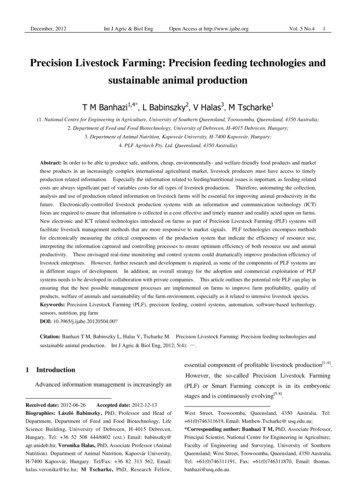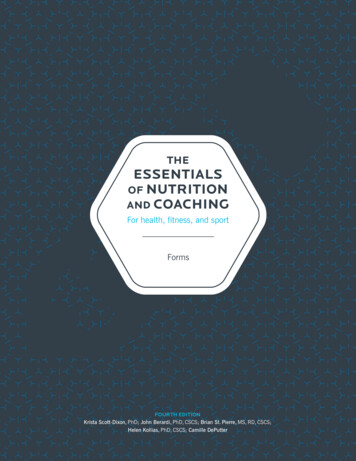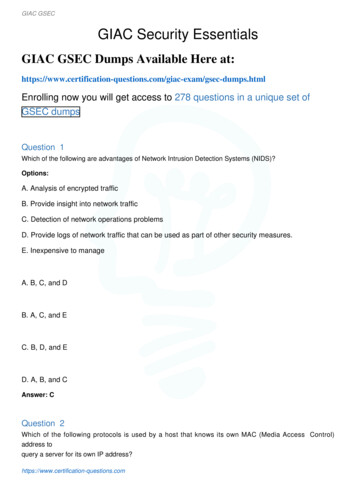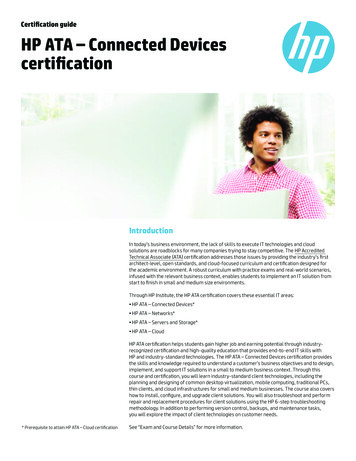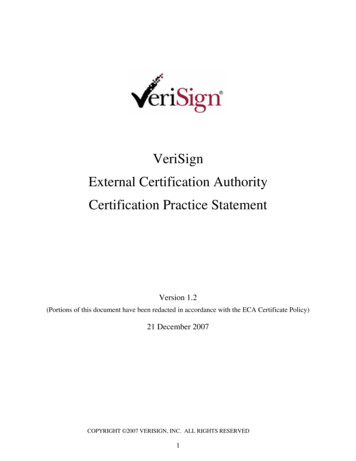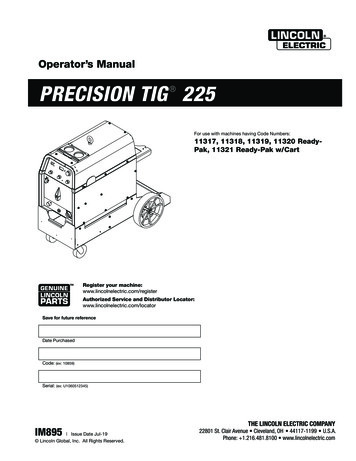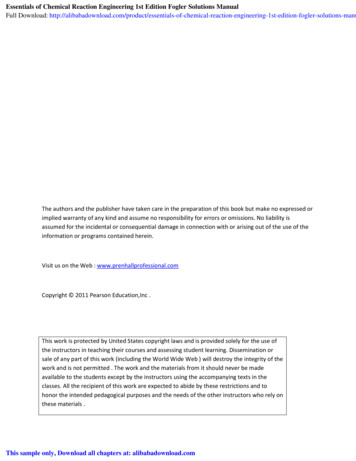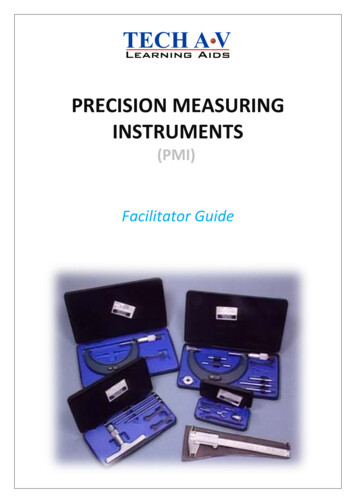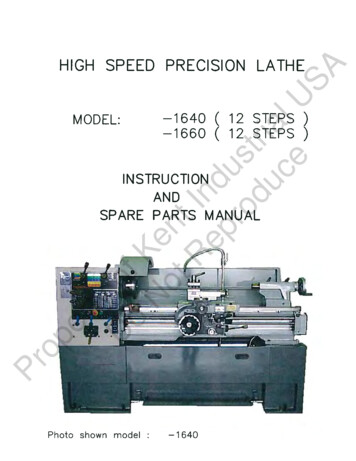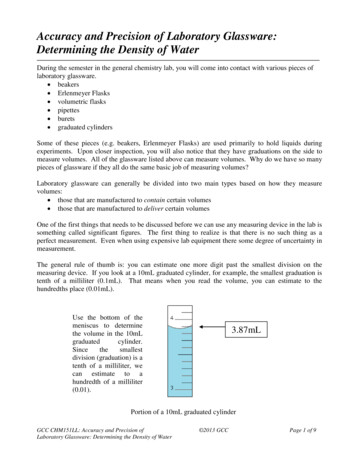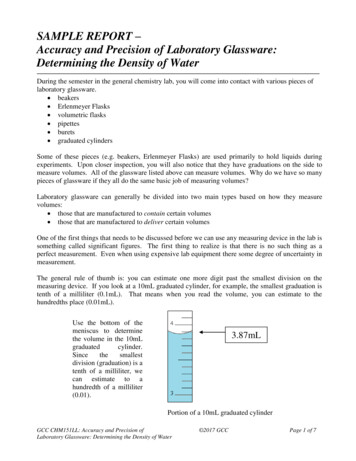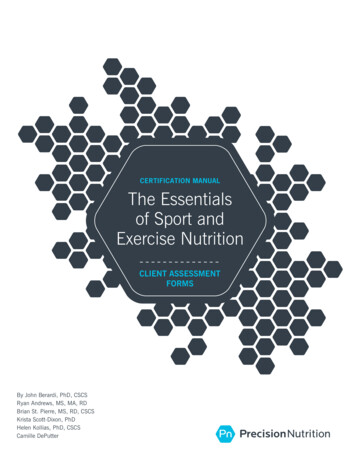
Transcription
CERTIFICATION MANUALThe Essentialsof Sport andExercise NutritionCLIENT ASSESSMENTFORMSFORMSBy John Berardi, PhD, CSCSRyan Andrews, MS, MA, RDBrian St. Pierre, MS, RD, CSCSKrista Scott-Dixon, PhDHelen Kollias, PhD, CSCSCamille DePutter
Copyright 2016 by Precision NutritionAll rights reserved. No part of this book may be reproduced or transmitted inany form or by any means, electronic or mechanical, including photocopying,recording, or by any information storage and retrieval system, without writtenpermission from the publisher.Published by Precision Nutrition, Inc.www.precisionnutrition.com
PRECISION NUTRITION FORMS IntroductionWhen to use the formsOutcome-baseddecision making.It’s at the heart of everything you do as a coach.1. You gather data.2. You analyze it.3. You decide what to do next, based on the evidence.As the saying goes:“If you’re not assessing, you’re guessing.”Indeed, the best coaches are always gathering, analyzing, and using data to make informed,outcome-based decisions.However, sometimes all that data can feel overwhelming.Each client comes to you with: different life experiences and a different personality; different wants and needs; different health conditions, movement capacities, and eating habits; different problem-solving abilities; and different attitudes about change and trying new things.As a coach, you need to triage — to understand what’s most important, right now, for eachunique client. Triaging helps you focus on “first things first” and set the right priorities.But how do you know: What information to gather? And when? What questions to ask? And how? The right way to discuss assessment and analysis with clients? How to walk them through the process step by step?Simple.We’ve already done the work for you.The assessment forms in this package will help you get to know your client better, and helpyou make better, evidence-based decisions about your coaching strategy.Using them, you’ll learn more about your client’s: Physiological indicatorsThis includes blood work, other lab tests, digestive function, and immunity
PRECISION NUTRITION FORMS IntroductionWhen to use the forms Body composition and measurementsThis includes height, weight, body girths, lean mass, and body fat Other health needsThis includes known allergies or food intolerances, medication use, other health problems,and the other health care providers they work with Function and physical capabilityThis includes mobility, daily-life tasks, and athletic performance Psychological state and mindsetThis includes readiness for change, resilience, and problem solving Environment and lifestyleThis includes social support, family, work hours and demands, and travel Goals and desired outcomesThis includes a specific goal weight or body composition change, decreased medicationusage, improved performance measures, and improved relationship with foodBuild your “coaching information database” by using these tools and techniques. And use itto generate strategic plans that your clients can stick with, and that you can feel good about.START WITH THE BASICS.We suggest you begin with The PN Initial Assessment and Triage Questionnaire, which covers: The client’s perspectiveThis includes expectations, goals, self-identified limiting factors, willingness to change, andwhat behaviors they’d like to focus on or change. Social factorsThis includes social support, stress, and relationships. Health indicators and conditionsThis includes injuries, medication use, and digestion. Lifestyle factorsThis includes how often they see the doctor, whether they smoke, how they spend theirtime, and how their kitchen is set up.Ask the client to fill it out beforehand if possible and bring it to your first session together.Filling out forms in advance gives them time to think and remember details.At that first session, discuss their responses with them. Look for more information, and try tounderstand their situation as much as you can. Going through the forms together gives youboth an opportunity to fill in any gaps and make sure you’re both on the same page.A good initial assessment helps you match your coaching plan to what the client can actuallyunderstand, manage, and do. This ensures that your clients go steadily from success tosuccess, rather than swinging wildly from resistance to anxiety to failure.The initial assessment also helps you to give clients an objective appraisal of what and howthey’re doing, helps you identify clients who are at risk for illness and / or injury, and helpsyou determine if you need to refer a client out, either because they fall outside your scopeof practice or because the relationship would be a mismatch (remember, referring out is animportant and valuable option).
PRECISION NUTRITION FORMS IntroductionWhen to use the formsAfter the first session, if you feel like the Initial Assessment and Triage Questionnaire raisessome additional questions you’d like to answer immediately, use some of the questionnairesand worksheets included here. These may help you: identify what’s most important to your client right now; learn what “progress” means for your client; identify specific ways to track progress with your client; collaborate on next actions together; ensure that your client is able to execute any tasks you give them; and / or focus on a particular area of interest, such as past / current health problems, sportnutrition, readiness for change, planning and time useKeep in mind: You don’t have to use all of these. We recommend you only try one at a time. Feel free to use them throughout the entire coaching process. Only use a form if you find it useful when making coaching decisions.COACH AND CLIENT FORMSMany of the forms have “coach” and “client” versions.CThe “coach version” is like a teacher’s guide to a classroom textbook. It explainswhat the form is used for, how to talk about the form with your clients, and whyyou might ask for certain types of information from your clients. Coach versionshave the symbol C.The “client version” is what your clients will see. Simple, to the point, only asking what’sneeded for each topic. You can give these to your client to fill out at home and bring toyour sessions.We suggest you review the “coach version” of each form before handing the “client” versionout. This will help you feel ready and able to explain each form. This will, in turn, help yourclients better understand what you’re hoping to accomplish and “buy in” to the process.
PRECISION NUTRITION FORMS IntroductionWhen to use the formsIndex of Precision Nutrition formsHere’s a list of all the worksheets, assessments and questionnaires contained in thispackage, including what each is used for.Index of formsWORKSHEET, ASSESSMENT,OR QUESTIONNAIREWHAT IT’S USED FORVERSIONSPN Initial Assessmentand Triage QuestionnaireHelps you match your coaching plan to what the client canactually understand, manage, and do. Also helps you togive clients an objective appraisal of what and how they’redoing, helps you identify clients who are at risk for illnessand / or injury, and helps you determine if you need to refera client out.Coach version14 Crazy Questions WorksheetFor helping clients think through the benefits of the statusquo and what they’ll have to give up to change.Client versionA-B-C WorksheetFor negotiating which specific exercises and / or foods clientscan / will do or eat. (At least right now.)Coach versionFor helping clients see choices as a continuum versusall or nothing.Coach versionAthletic Nutrition NeedsQuestionnaireFor understanding a client’s training goals, training volume,current recovery practices, and current nutrition practices.Coach versionBaseline Blood ChemistryAssessmentFor coaches who find blood work useful in the decisionmaking process.Coach versionBehavior Awareness WorksheetFor helping clients change unwanted habits and behaviors(such as stress eating).Client versionBody Measurements FormFor tracking body composition in clients who might benefitfrom regular measures.Coach versionEating Habits QuestionnaireFor learning more about a client’s eating patterns.Coach versionAll-or-None WorksheetClient version2Client versionClient versionClient versionClient version1 Coach versions contain scripts or background information that that you can use to either explain the form to yourclients, or to understand why we’ve asked certain questions. It’s like a “Teacher’s guide” for school teachers.2 Client versions of forms are for the clients to take home and fill out themselves.
PRECISION NUTRITION FORMSWORKSHEET, ASSESSMENT,OR QUESTIONNAIRE IntroductionWhen to use the formsWHAT IT’S USED FORVERSIONS3-Day Diet RecordFor recording exactly what a client is eating; most often forLevel 2 eaters.Client version80% Full Meal JournalFor helping clients learn how to eat until satisfied versusstuffed and tracking progress in this area.Client versionAthletic PerformanceIndicators & AthleteNutrition JournalFor correlating mood, energy, and motivation withdietary intake in hard-training athletes. Includes AthleticPerformance Indicators worksheet.Client versionEating Behaviors JournalFor capturing a client’s urges, cravings, and behaviors aroundmeals.Client versionEating Slowly Meal Journaland Meal Duration JournalFor tracking a client’s meal speed and whether they’reconsistently eating slowly and mindfully. Use Eating Slowlyfor subjective self-assessment or Meal Duration for objectiveself-assessment.Client versionEmotional Eating JournalFor capturing a client’s emotions and thoughts and how theymight lead to different food choices.Client versionHow Food Feels JournalFor capturing a client’s physical sensations (like allergies orintolerances) related to food.Client versionHand-Sized Portion GuideA simple guide to calorie control without calorie tracking.Client versionIdeas for MovementSuggestions for daily movement outside of scheduled“exercise”.Coach versionFor helping highlight the relationship between a client’senvironment and their food habits.Coach versionLimiting Factors, Advantages,and Behavior Goals LogFor identifying a client’s struggles, their advantages, and howto turn them into a plan for change.Coach versionMake It A Habit WorksheetFor moving from vague idea or outcome goal to specific habitand behavior goal.Coach versionMeal Consistency WorksheetFor tracking a client’s consistency with agreed-uponbehaviors and practices.Coach versionFOOD JOURNALSKitchen Set-up AssessmentClient versionClient versionClient version
PRECISION NUTRITION FORMS IntroductionWhen to use the formsWORKSHEET, ASSESSMENT,OR QUESTIONNAIREWHAT IT’S USED FORVERSIONSMedical History and PresentMedical Condition Questionnaire3Provides more detailed information about the client’soverall health.Coach versionPlanning & Time Use WorksheetFor clients who have problems with time management.Client versionPrecision Nutrition PlateA simple way to structure each meal the PrecisionNutrition way.Client versionPush-Pul-Habit-AnxietyWorksheetFor identifying what’s pushing clients away from old ways ofdoing things and pulling them towards new things.Coach versionReady, Willing, and AbleWorksheetFor helping establish how ready, willing, and able a clientis to make a given change. Also helps coaches “shrink thechange” to make it more manageable.Client versionSleep & Recovery IdeasFor helping coaches discuss sleep rituals and stressmanagement.Coach versionFor showing how social support influences a client’s eatingand movement decisions.Coach versionFor helping clients identify what they have control over and don’t.Coach versionFor showing patterns of sleep, stress, and recovery.Coach versionSocial Support FormSphere of Control WorksheetStress & Recovery QuestionnaireClient versionClient versionClient versionClient versionClient versionThe Hunger GameFor helping clients better tune into hunger and appetite cues.Client versionWant-Willing-Won’t WorksheetFor negotiating what clients want, and what they’re willing todo (or not do) for that goal right now.Coach versionClient version3 Remember that Medical Nutrition Therapy is off limits unless you’re a registered dietitian. We include this formso you can have access to the client’s medical history in case that needs to inform your advice.
PRECISION NUTRITION FORMS IntroductionWhen to use the formsUsing The Precision Nutrition FormsHere’s how to choose which form to use when.Session 1:Initial Assessment& Triage FormEnough data for now?YMove to exploring,understanding andworking withlimiting factorsNUse appropriateassessment forms;collect only the datayou needBodycomposition orweight changegoalPast or currenthealth problemsMedical History & PresentMedical ConditionBaseline Blood ChemistryAthletic / sportsnutritionAthletic Nutrition NeedsAthletic Nutrition JournalReadiness forchangeReady, Willing, AbleA-B-CWant-Willing-Won'tQuality of eatinghabitsHOW TO GET THE MOST OUT OF OUR ASSESSMENT FORMSBody MeasurementsStep 1: Eating HabitsStep 2: How Food Feels;Behavior Awareness;Meal ConsistencyStep 3: 3-day dietary recordPlanning& time usePlanning & Time UseSphere of ControlWant-Willing-Won’tSocial supportand householdSocial SupportKitchen Set-upStress andrecoveryStress & RecoverySphere of ControlPlanning & Time UseKeep it simple.Use as few forms as possible. Gather only the information you need right now.Have a conversation first.Use the forms to open up a discussion with your client. Ask for moreexplanation about their answers, or “Tell me about ”Address one thing at a time.Collaborate with your client on setting priorities and deciding what is mostimportant to work on.Make outcome-based decisions.Decide what to do next based on the evidence and information you have.Client progressionLimiting Factors,Advantages, and BehaviorGoalsMake It A HabitWant-Willing-Won't
CPN Initial Assessment & Triage QuestionnaireNAMEDATECoaching tips You can use this form both for an initial baseline assessment and
PRECISION NUTRITION FORMS Introduction . When to use the forms. Outcome-based decision making. It’s at the heart of everything you do as a coach. 1. You gather data. 2. You analyze it. 3. You decide what to do next, based on the evidence. As the saying
